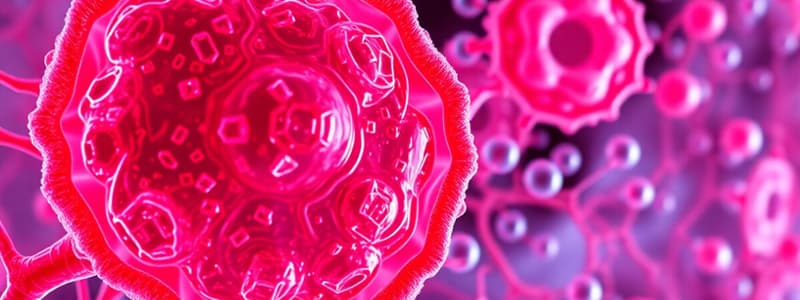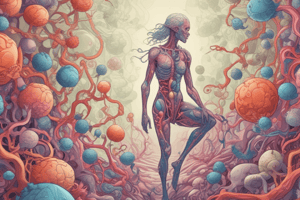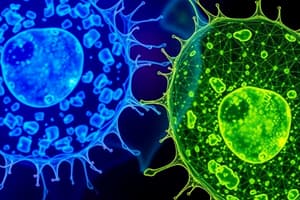Podcast
Questions and Answers
In what level of organization is a nerve cell considered?
In what level of organization is a nerve cell considered?
- Cellular level (correct)
- Tissue level
- System level
- Organismal level
Which of the following is NOT a characteristic of living things?
Which of the following is NOT a characteristic of living things?
- Homeostasis
- Gravity (correct)
- Reproduction
- Metabolism
What is the process of breaking down large molecules into small ones called?
What is the process of breaking down large molecules into small ones called?
- Growth
- Anabolism
- Catabolism (correct)
- Adaptation
Which tissue type is responsible for movement?
Which tissue type is responsible for movement?
What is the main function of the digestive system?
What is the main function of the digestive system?
Which of the following is NOT a shared component of all cells?
Which of the following is NOT a shared component of all cells?
What is the primary function of the integumentary system?
What is the primary function of the integumentary system?
Which of the following is NOT a characteristic of the nervous system?
Which of the following is NOT a characteristic of the nervous system?
What is the difference between totipotent and differentiated cells?
What is the difference between totipotent and differentiated cells?
Which tissue type is primarily responsible for movement?
Which tissue type is primarily responsible for movement?
What is the function of the lymphatic system?
What is the function of the lymphatic system?
Which of the following is an example of an organ?
Which of the following is an example of an organ?
Which of the following organ systems is responsible for regulating blood volume and excretion?
Which of the following organ systems is responsible for regulating blood volume and excretion?
Which of the following best describes the relationship between organ systems?
Which of the following best describes the relationship between organ systems?
What is the primary function of the endocrine system?
What is the primary function of the endocrine system?
Which of the following is NOT a function of the digestive system?
Which of the following is NOT a function of the digestive system?
What is the difference between the axial and appendicular regions of the body?
What is the difference between the axial and appendicular regions of the body?
What is the role of the musculoskeletal system in blood cell production?
What is the role of the musculoskeletal system in blood cell production?
Which of the following statements about cell differentiation is TRUE?
Which of the following statements about cell differentiation is TRUE?
How does the arrangement of tissues determine the structure and function of organs?
How does the arrangement of tissues determine the structure and function of organs?
Which statement best describes the relationship between cells and the overall function of an organism?
Which statement best describes the relationship between cells and the overall function of an organism?
What is the pericardium?
What is the pericardium?
Which of the following structures is NOT located in the mediastinum?
Which of the following structures is NOT located in the mediastinum?
What is the function of the diaphragm?
What is the function of the diaphragm?
Which of the following organs is NOT found in the abdominal cavity?
Which of the following organs is NOT found in the abdominal cavity?
What is the name of the region of the abdominopelvic cavity that is located below the superior ridge of the hips?
What is the name of the region of the abdominopelvic cavity that is located below the superior ridge of the hips?
Which of the following terms refers to a region of the abdominopelvic cavity that is located above another region?
Which of the following terms refers to a region of the abdominopelvic cavity that is located above another region?
Which of the following is NOT a descriptive term used to identify regions of the abdominopelvic cavity?
Which of the following is NOT a descriptive term used to identify regions of the abdominopelvic cavity?
What is the name of the region of the abdominopelvic cavity that is named for the umbilicus?
What is the name of the region of the abdominopelvic cavity that is named for the umbilicus?
What is the name of the region of the abdominopelvic cavity that is located lateral to the umbilical region?
What is the name of the region of the abdominopelvic cavity that is located lateral to the umbilical region?
What is the name of the region of the abdominopelvic cavity that is located below the umbilical region?
What is the name of the region of the abdominopelvic cavity that is located below the umbilical region?
Which of the following is NOT a quadrant of the abdominopelvic cavity?
Which of the following is NOT a quadrant of the abdominopelvic cavity?
What is the anatomic position?
What is the anatomic position?
What is the name of the plane that divides the body into anterior and posterior sections?
What is the name of the plane that divides the body into anterior and posterior sections?
Which of the following describes the plane that divides the body into left and right halves?
Which of the following describes the plane that divides the body into left and right halves?
What is the term for a body’s ability to maintain relatively stable internal conditions?
What is the term for a body’s ability to maintain relatively stable internal conditions?
Which of the following is NOT a component of the thoracic cavity?
Which of the following is NOT a component of the thoracic cavity?
Which of the following is NOT considered part of the axial region of the body?
Which of the following is NOT considered part of the axial region of the body?
What is the primary function of the serous fluid within the body's cavities?
What is the primary function of the serous fluid within the body's cavities?
Which of the following cavities is located within the posterior aspect of the body?
Which of the following cavities is located within the posterior aspect of the body?
What is the name of the serous membrane that surrounds the lungs?
What is the name of the serous membrane that surrounds the lungs?
The abdominal and pelvic cavities are separated by which structure?
The abdominal and pelvic cavities are separated by which structure?
Which of the following statements accurately describes the relationship between the parietal and visceral layers of serous membranes?
Which of the following statements accurately describes the relationship between the parietal and visceral layers of serous membranes?
What is the main difference between a true cavity and a general hollow area within the body?
What is the main difference between a true cavity and a general hollow area within the body?
Which of these is NOT a characteristic of the ventral cavity?
Which of these is NOT a characteristic of the ventral cavity?
What is the term used to describe the normal range for a regulated variable in the body?
What is the term used to describe the normal range for a regulated variable in the body?
Which component of a regulatory system is responsible for detecting changes in a variable?
Which component of a regulatory system is responsible for detecting changes in a variable?
In the context of homeostasis, what is the role of the effector?
In the context of homeostasis, what is the role of the effector?
Which type of feedback mechanism is most common in maintaining homeostasis?
Which type of feedback mechanism is most common in maintaining homeostasis?
How does negative feedback differ from positive feedback?
How does negative feedback differ from positive feedback?
Which of the following is an example of positive feedback?
Which of the following is an example of positive feedback?
Homeostasis refers to:
Homeostasis refers to:
Flashcards
Metabolism
Metabolism
The sum of chemical reactions that drive life functions in organisms.
Anabolism
Anabolism
The process of building large molecules from small molecules in metabolism.
Catabolism
Catabolism
The process of breaking large molecules into smaller ones in metabolism.
Homeostasis
Homeostasis
Signup and view all the flashcards
Levels of organization
Levels of organization
Signup and view all the flashcards
Axial Region
Axial Region
Signup and view all the flashcards
Appendicular Region
Appendicular Region
Signup and view all the flashcards
Body Cavity
Body Cavity
Signup and view all the flashcards
Dorsal Cavity
Dorsal Cavity
Signup and view all the flashcards
Cranial Cavity
Cranial Cavity
Signup and view all the flashcards
Ventral Cavity
Ventral Cavity
Signup and view all the flashcards
Serosa
Serosa
Signup and view all the flashcards
Parietal and Visceral Layers
Parietal and Visceral Layers
Signup and view all the flashcards
Diaphragm
Diaphragm
Signup and view all the flashcards
Cell Theory
Cell Theory
Signup and view all the flashcards
Components of Cells
Components of Cells
Signup and view all the flashcards
Cell Differentiation
Cell Differentiation
Signup and view all the flashcards
Types of Tissues
Types of Tissues
Signup and view all the flashcards
Organs
Organs
Signup and view all the flashcards
Integumentary System
Integumentary System
Signup and view all the flashcards
Nervous System
Nervous System
Signup and view all the flashcards
Musculoskeletal System
Musculoskeletal System
Signup and view all the flashcards
Respiratory System
Respiratory System
Signup and view all the flashcards
Cardiovascular System
Cardiovascular System
Signup and view all the flashcards
Immune System
Immune System
Signup and view all the flashcards
Endocrine System
Endocrine System
Signup and view all the flashcards
Urinary System
Urinary System
Signup and view all the flashcards
Digestive System
Digestive System
Signup and view all the flashcards
Regional Anatomical Terms
Regional Anatomical Terms
Signup and view all the flashcards
Variable
Variable
Signup and view all the flashcards
Stimulus
Stimulus
Signup and view all the flashcards
Sensor (Receptor)
Sensor (Receptor)
Signup and view all the flashcards
Controller
Controller
Signup and view all the flashcards
Effector
Effector
Signup and view all the flashcards
Set Point
Set Point
Signup and view all the flashcards
Negative Feedback
Negative Feedback
Signup and view all the flashcards
Pleural Cavities
Pleural Cavities
Signup and view all the flashcards
Visceral Pleura
Visceral Pleura
Signup and view all the flashcards
Parietal Pleura
Parietal Pleura
Signup and view all the flashcards
Mediastinum
Mediastinum
Signup and view all the flashcards
Pericardial Cavity
Pericardial Cavity
Signup and view all the flashcards
Parietal Pericardium
Parietal Pericardium
Signup and view all the flashcards
Visceral Pericardium
Visceral Pericardium
Signup and view all the flashcards
Abdominopelvic Cavity
Abdominopelvic Cavity
Signup and view all the flashcards
Abdominal Cavity
Abdominal Cavity
Signup and view all the flashcards
Pelvic Cavity
Pelvic Cavity
Signup and view all the flashcards
Abdominopelvic Regions
Abdominopelvic Regions
Signup and view all the flashcards
Directional Terms
Directional Terms
Signup and view all the flashcards
Body Planes
Body Planes
Signup and view all the flashcards
Coronal Plane
Coronal Plane
Signup and view all the flashcards
Study Notes
Characteristics of Living Things
- Living organisms produce and consume energy to function
- Metabolism encompasses all chemical reactions essential for life processes
- Anabolism is the building of complex molecules from simpler ones
- Catabolism is the breakdown of complex molecules into simpler ones
- Living organisms grow and repair themselves, often specializing according to function
- Mechanisms exist to fix malfunctioning cells
- Adaptation is the ability to respond to environmental changes
- Homeostasis is a vital process to maintain a stable internal environment
- Reproduction allows for the creation of new organisms (either cellular or organismal level)
Levels of Organization in the Body
- Chemical level: Atoms and molecules form the basic building blocks of the body
- Cellular level: Cells are the fundamental units of life, each performing specific functions in tissues
- Tissue level: Similar cells grouped together form tissues, performing common functions
- Organ level: Two or more tissue types working together form organs with specialized roles
- System level: Various organs cooperate to accomplish a complex set of functions
- Organismal level: All structural levels interact to maintain the organism's overall functions
Cell Theory
- All organisms are composed of one or more cells
- Cells are the fundamental unit of life and carry out essential biological functions
- Cells originate only from previously existing cells
- Heredity information directs the creation of biomolecules and enables reproduction
Cells Are the Living Unit of Life
- Cells are the fundamental building blocks of tissue
- Cells maintain homeostasis
- All cells share basic components: membrane, genetic material, and cytosolic fluid
- Specialized organelles within human cells lead to compartmentalization and complexity
- Gene expression leads to cell specialization
Cell Differentiation
- Cells develop unique features and functions during specialization
- Cell specialization is often irreversible in differentiated cells
- All cells start as unspecialized totipotent stem cells
- As tissues develop, stem cells differentiate to perform specific functions
Tissues
- Tissues are groups of similar cells with a shared structure and function
- Four basic tissue types: Epithelial, Connective, Muscle, Nervous
- Each tissue type performs specific roles critical for organ function
Integrating Tissues: Organs
- Organs are structures composed of 2 or more tissue types working together
- Different tissues cooperate within organs to produce complex functions
Intro to the Organ Systems
- Integumentary System: Skin, hair, nails, glands contribute to protection and temperature regulation
- Nervous System: Brain, spinal cord, nerves facilitate detection of internal and external stimuli and physiological responses
- Musculoskeletal System: Bones, muscles, cartilage, tendons, and ligaments provide support, protection, and mobility along with blood cell production
Intro to the Organ Systems (cont. 1)
- Respiratory System: Nasal passages, trachea, lungs facilitate gas exchange
- Cardiovascular System: Heart, blood vessels, and blood move materials throughout the body
- Immune and Lymphatic Systems: Lymphoid organs and cells contribute to defending against pathogens
- Endocrine System: Glands release hormones coordinating growth, metabolism, and other physiological processes
Intro to the Organ Systems (cont. 2)
- Urinary System: Kidneys, ureters, bladder, and urethra maintain fluid balance and excrete waste
- Digestive System: Mouth, esophagus, stomach, intestines, and associated organs digest food and process nutrients
- Reproductive System: Organs (male and female) facilitate reproduction
Regional Anatomical Terms
- Main Regions: Axial (head, neck, trunk) and Appendicular (arms, legs, girdles)
- Specific Regions: Detailed divisions within the main regions
The Body Cavities
- Cavities are hollow spaces within the body, containing organs or holding them in place
- Posterior aspect cavities (cranial and vertebral) are completely encased in bone
- Ventral cavity is larger and is anteriorly placed, divided into thoracic and abdominopelvic regions
Serosa
- Serous membranes form thin, double-layered sacs surrounding organs in the ventral body cavity
- Parietal layer lines the cavity wall, visceral layer covers the organ
- Serous fluid between these layers reduces friction
The Thoracic Cavity
- Primarily the chest cavity, encased by ribs and chest muscles
- Contains three divisions: pleural cavities (surrounding the lungs), mediastinum (between the lungs), and pericardial cavity (surrounding the heart)
The Abdominopelvic Cavity
- Divided into two cavities: The superior abdominal cavity and the inferior pelvic cavity
- Contains organs of the digestive system, excretory system and reproductive systems
Abdominopelvic Regions
- The abdominopelvic region is divided into four quadrants and nine regions based on anatomical landmarks
- Quadrant and region divisions are used for easier anatomical reference
Directional Terms
- Anatomical directional terms describe locations of body structures relative to each other
- Anterior/Posterior, Superior/Inferior, Medial/Lateral, Proximal/Distal, Superficial/Deep are key concepts
Body Planes and Sections
- Anatomical position (upright, arms at side, palms forward) is the reference point
- Planes (coronal, transverse, midsagittal) are used for dividing the body into sections
Homeostasis
- Ability to maintain relatively stable internal conditions despite external changes
- Dynamic state of equilibrium
- Crucial for physiological function
- Homeostasis is achieved through regulatory feedback mechanisms
Homeostasis (components)
- Variable: The substance or physiological process being regulated
- Stimulus: Initiates the homeostatic process
- Receptor: Detects the change in the variable
- Controller: Integrates input from the receptor and directs an appropriate response
- Effector: Brings about the changes needed to restore homeostasis
- Set point: The normal range for the variable
Negative v. Positive Feedback
- Negative feedback loops reverse a change, maintaining a set point
- Positive feedback loops enhance a change
- Common examples of homeostasis regulation mechanisms
Studying That Suits You
Use AI to generate personalized quizzes and flashcards to suit your learning preferences.




